2003 Robot Hall Of Fame inductees
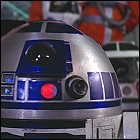
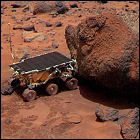 The first four inductees – two real and two fictional – are inducted into the Robot Hall Of Fame created by Carnegie Mellon University’s School of Computer Science.
The first four inductees – two real and two fictional – are inducted into the Robot Hall Of Fame created by Carnegie Mellon University’s School of Computer Science.
- Unimate (1961, General Motors) – the first robotic arm used in car assembly
- HAL-9000 (1968, from 2001: a space odyssey)
- R2-D2 (1977, from Star Wars)
- Sojourner (1996, NASA) – the first successful Mars rover
The panel of judges in future years will pare down the number of nominations awarded to fictional creations. R2-D2 actor Kenny Baker and Douglas Rains, the voice actor behind HAL, are in attendance.
Pathfinder falls silent
 Its ability to recharge its power supply depleted, the Mars Pathfinder lander – now dubbed Sagan Memorial Station – ceases its transmissions to Earth, also cutting off communication with the Sojourner Mars rover. Originally intended for a month-long mission, Pathfinder and Sojourner last three times that long, and give scientists and engineers a wealth of data for planning the twin Mars Exploration Rovers. NASA declares the Pathfinder mission a complete success in early 1998.
Its ability to recharge its power supply depleted, the Mars Pathfinder lander – now dubbed Sagan Memorial Station – ceases its transmissions to Earth, also cutting off communication with the Sojourner Mars rover. Originally intended for a month-long mission, Pathfinder and Sojourner last three times that long, and give scientists and engineers a wealth of data for planning the twin Mars Exploration Rovers. NASA declares the Pathfinder mission a complete success in early 1998.
Red planet rover, please come over
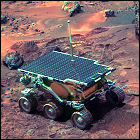 Sojourner, the original Mars rover, rides out on the Martian surface, getting close-up looks at nearby rocks and demonstrating technologies that are vital to upcoming Mars missions, including automatic hazard detection and avoidance. Sojourner’s ability to “see” obstacles and navigate around them without advice from ground controllers will be essential to later Mars rovers, since it takes seven minutes for a signal to reach Earth, and seven more minutes for instructions to return. The rover captures the public imagination and is even immortalized as a Hot Wheels toy.
Sojourner, the original Mars rover, rides out on the Martian surface, getting close-up looks at nearby rocks and demonstrating technologies that are vital to upcoming Mars missions, including automatic hazard detection and avoidance. Sojourner’s ability to “see” obstacles and navigate around them without advice from ground controllers will be essential to later Mars rovers, since it takes seven minutes for a signal to reach Earth, and seven more minutes for instructions to return. The rover captures the public imagination and is even immortalized as a Hot Wheels toy.
Pathfinder bounces onto Mars
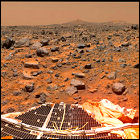 Using a never-before-attempted system of landing, the Mars Pathfinder unmanned probe employs an aerobraking maneuver to slow down in the planet’s atmosphere, and an all-encompassing layer of airbags to “bounce” onto the surface without using rockets to slow the vehicle down. The weighted landing station rolls to the correct orientation, deflates the airbags, and deploys on schedule, proving the merits of a landing technique that will deliver future Mars landers already in the planning stages.
Using a never-before-attempted system of landing, the Mars Pathfinder unmanned probe employs an aerobraking maneuver to slow down in the planet’s atmosphere, and an all-encompassing layer of airbags to “bounce” onto the surface without using rockets to slow the vehicle down. The weighted landing station rolls to the correct orientation, deflates the airbags, and deploys on schedule, proving the merits of a landing technique that will deliver future Mars landers already in the planning stages.
Pathfinder bounces into toy stores
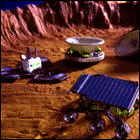 American toy company Mattel releases a Mars Pathfinder playset as part of its venerable Hot Wheels range of toy cars. The set includes miniature replicas of Pathfinder’s atmospheric entry capsule (complete with removable backshell) and the three-petaled Pathfinder landing station, but the highlight is the intricately (and very accurately) detailed miniature Sojourner Mars rover. Mattel has licensed the patented designs of the spacecraft through JPL’s Technology Affiliates program.
American toy company Mattel releases a Mars Pathfinder playset as part of its venerable Hot Wheels range of toy cars. The set includes miniature replicas of Pathfinder’s atmospheric entry capsule (complete with removable backshell) and the three-petaled Pathfinder landing station, but the highlight is the intricately (and very accurately) detailed miniature Sojourner Mars rover. Mattel has licensed the patented designs of the spacecraft through JPL’s Technology Affiliates program.
Pathfinder en route to Mars
 NASA/JPL’s low-cost Mars Pathfinder mission lifts off for a date with Mars. The first American Mars lander since the Viking missions of the 1970s, Pathfinder is practically an interplanetary tech demonstration, showing off new landing techniques (aerobraking and landing airbags), new lander designs (a fixed station delivering a wheeled “rover”), and the beginning of a new commitment to exploring Mars. By the time operations are wrapped up on the Pathfinder mission, the total amount of money spent is under $300,000,000.
NASA/JPL’s low-cost Mars Pathfinder mission lifts off for a date with Mars. The first American Mars lander since the Viking missions of the 1970s, Pathfinder is practically an interplanetary tech demonstration, showing off new landing techniques (aerobraking and landing airbags), new lander designs (a fixed station delivering a wheeled “rover”), and the beginning of a new commitment to exploring Mars. By the time operations are wrapped up on the Pathfinder mission, the total amount of money spent is under $300,000,000.
The future of Mars exploration
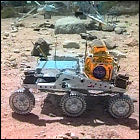 A tech demonstration at the Jet Propulsion Laboratory leads to a rethink of the upcoming Mars Environmental Survey mission (MESUR). A self-contained “rover” named Rocky IV convinces mission planners to include a similar rover on an upcoming Mars mission; although the rest of MESUR is eventually scrapped due to budget cuts, the one portion of it to be salvaged is the Mars Pathfinder lander, which will deliver the rover (later to be named Sojourner in a nationwide contest) to the Martian surface sometime in the late ’90s.
A tech demonstration at the Jet Propulsion Laboratory leads to a rethink of the upcoming Mars Environmental Survey mission (MESUR). A self-contained “rover” named Rocky IV convinces mission planners to include a similar rover on an upcoming Mars mission; although the rest of MESUR is eventually scrapped due to budget cuts, the one portion of it to be salvaged is the Mars Pathfinder lander, which will deliver the rover (later to be named Sojourner in a nationwide contest) to the Martian surface sometime in the late ’90s.